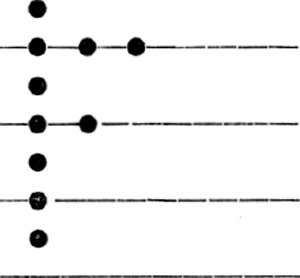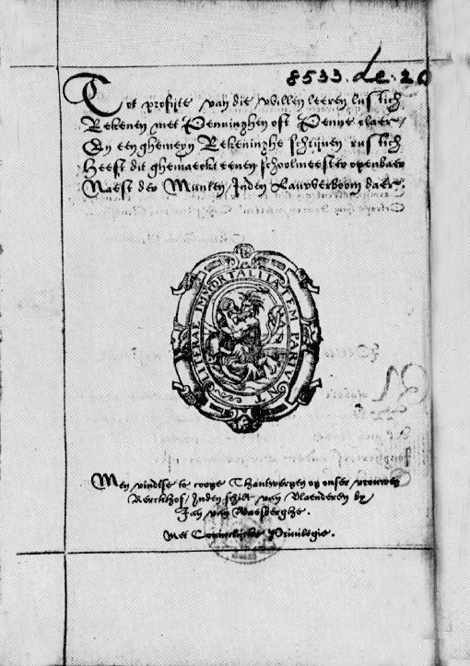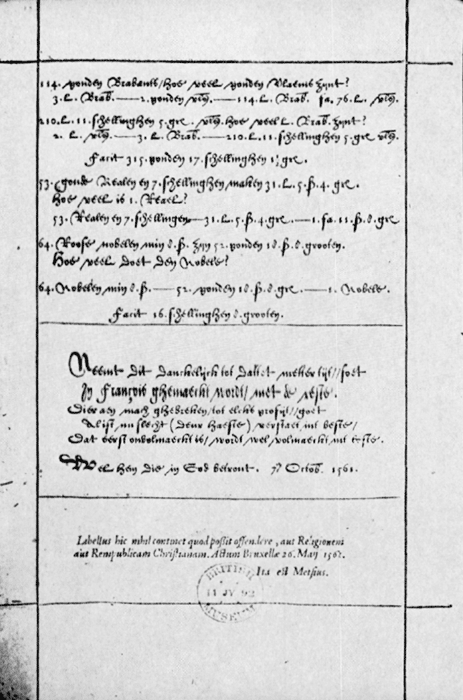De Gulden Passer. Jaargang 33
(1955)– [tijdschrift] Gulden Passer, De–
[pagina 36]
| |
A secret of the Laurel-tree unveiled
| |
[pagina 37]
| |
This intrigued me, since all the biographical notices I had ever come across concerning Heyns clearly stated that his first published work was the contribution he made to the haechspel of 1561 as ‘factor,’ or accredited poet, to the Chamber of Rhetoric the Bloeyenden Wijngaert at Berchem. This took the form of a Spel van Sinne and a Factie which were published in 1562 by Willem SilviusGa naar voetnoot(1). Here, therefore, was an apparently unknown book of Peeter Heyns and, unless something else comes to light later, his first published work. Upon examining the book itself, a small quarto booklet of 42 pages and an index, I found that it was published by Jan van Waesberghe inden schilt van Vlaenderen. Yet consultation of Ledeboer's Het geslacht van Waesberghe threw no light on the matter; the only publication there listed for the year 1561 was La belle et plaisante histoire des quatre fils Aymon. I had, then, come across a hitherto unrecorded publication of Jan van Waesberghe. Yet a further interesting disclosure was made on examination of the book, for with the exception of the approbatio, the entire work is printed in the civilité type of Ameet Tavernier; an early example of this script, which is said to have been first used by Tavernier in La Civilité puérile published by Jean Bellère in 1559Ga naar voetnoot(2).
The title page runs as follows: Tot profitje van de willen leeren lustich /
Rekenen met Penninghen oft Penne claer /
En eenghemeyn Rekeninghe schrijven rustich /
Heeft dit ghemaeckt eenen schoolmeester openbaer /
Naest der Munten inden Lauwerboom daer /
[Waesberghe's first printer's mark - a vignette of Triton, with the motto: Literae Immortalitem Pariunt.] | |
[pagina 38]
| |
Title; verso, Privilege [ghegheven tot Bruessel, s.d.] (1 f.) - Arithmetical rules and examples (pp. 1-42) - Foot of page 42, valedictory verses by Peeter Heyns and his motto: Wel hem die in God betrout [7th October, 1561] and Approbatio, dated Bruxellae, 26th May, 1561. - Alphabetical cut-out thumb index (7 ff. f. [4]-h. 2.) Further research seemed to show that the book was unknown to specialists in the field of early mathematical books, for it is mentioned neither in Augustus de Morgan's Arithmetical Books from the Invention of Printing to the Present Time (London, 1847) nor in David Eugene Smith's Rara Arithmetica (New York, 2 vols, 1908).
Yet there were, however, two slight clues which had pointed to its probable existence. The first is contained in the excellent study by Dr. Maurits Sabbe on Peeter Heyns en de Nimfen uit den LauwerboomGa naar voetnoot(1), in which, discussing the text-books used by Heyns in his school, he lists a number of books, references to which he found in the manuscript note-book (M. 240) - now in the archives of the Plantin-Moretus Museum - in which Heyns jotted down various items in connection with his school. In this there is a list of textbooks used which includes ‘een rekenboeck’.
Since he was unaware of the existence of the book I have just described, Dr. Sabbe wrote: ‘Het is natuurlijk moeilijk, zooniet onmogelijk te bepalen welke werken en uitgaven P. Heyns bedoelt met “een rekenboeck,” etc.’ There seems to me, now, little doubt that it was the book cited above.
Yet another clue is to be found in Ledeboer's book. In the Appendix (Bijlage F.) the author gives a catalogue of books from the press of Jan van Waesberghe which that printer had to submit to the authorities after he had been imprisoned in the Steen in 1569 on a charge of suspected heresy. It is headed Catalogus librorum officinae Joannis Waesbergii quos ipsemet impressit, and ends with the statement Hoc libros impressi ego Joannes Waesbergius. | |
[pagina 39]
| |
Some eighty items are listed, among them being a ‘Cyfer oft Rekenboec.’ Part of Heyns's book deals with the system of reckoning by counters which was common in Western Europe during the 16th century, for we find it explained in such books as Robert Recorde's The Ground of Artes (London: R. Wolfe. 1543); Ein New Kurtz Rechenbüchlin (Frankfurt-am-Rhein: Herman Gülfferichen. 1546); La vraye manière pour apprendre a Chiffrer et compter par plume et gectz (Lyon: Claude Veycellier); and Die maniere om te leeren cifferen ende rekenen metter pennen ende metten penningen (Antwerpen: Willem Vorsterman. c. 1510). Thus we find in Heyns's book on the page bearing the signature A2, accompanied by a diagram, Maniere hoe men die penninghen leyt in simpel rekeninge, and on page 28, Maniere hoe men die penninghen leyt in multipliceren. This ‘accompting by counters’ says Robert Recorde, ‘doth not only serve for them that cannot write and reade, but also for them that can doe both, but have not at some times their pens or tables readie with them. This sort is in two forms commonly: the one by lines, and the other withoute lines. In that that hath lines, the lines doe stande for the order of places: and in that that hath no lines, there must be set in their steade so many counters as shall neede, for each line one, and they shall supplie the neede of the lines.’ This somewhat cryptic statement needs some explanation for those brought up in an age of adding-machines. Every counter placed on the units line stood for one, so that four counters on the units line would represent the number 4. In the ‘tens’ line, above it, every counter represented 10, so that two lines with four counters on the lower line and three counters on the one above stood for 34.  A third line, with two counters on it, would bring the total up to 234. When we come to 5, however, we notice that it was | |
[pagina 40]
| |
not represented by placing five counters on the line, but by putting one counter in the space above the line in which it ought to appear, but below the next line. Let us, as an example, take the number 8765. This was represented thus:  Any figure between 4 and 10 will require the counter in a void space above its line, together with a counter for each unit above 5. Thus the 5 in 8765 is shown by a counter placed between the first and second lines. The 6 in the ‘tens’ line is shown by a counter (representing 5) in the space above the second line, while the unit left over goes on to the second line. In the same way with 7, the 5 goes as a single counter above the third line, while the remaining units are represented by two counters on the third line. The 8 in the ‘thousands’ line is shown in the form of a single counter above the line for 5, and three counters on the line stand for the remaining units. The ‘thousands’ line itself was usually marked by a star. In the 16th century the curriculum of many schools prescribed a knowledge of cyphering and the casting of accounts. ‘This casting of accounts,’ says Foster Watson, in his English Grammar Schools to 1660, ‘probably was not the arithmetic of numbers, but of counters. This and “cyphering” were the technical terms for the two types of arithmetic, and they continued side by side for at any rate the 16th and 17th centuries.’ In a city of such commercial importance as was Antwerp in the 16th century it is certain that both cyphering and the casting | |
[pagina *5]
| |
 Title-page of the apparentiy unique copy of the ‘Rekenboeck’ of Peeter Heyns, now in the British Museum.
| |
[pagina *6]
| |
 Valedictory verses from the author, with his motto: ‘Wel hem die in Godt betrout’ (Happy he who puts his trust in God). At the foot of the page, the censor's approbatio, dated 26 May, 1561.
| |
[pagina 41]
| |
of accounts had an important place in any school curriculum, and as C.P. Burger Jr. has pointed out in an excellent paper on A.B.C.-Penningen of RekenpenningenGa naar voetnoot(1) ‘met de rekening met penningen kon het in de handelsstad ook dienen voor den kleinen man die lezen en schrijven niet of slecht kende, maar wel rekenen had te doen.’ All the matter contained in the little book of Peeter Heyns is eminently practical, for in addition to arithmetical tables and the explanation of such things as the ‘Rule of Three,’ we find pages devoted to such severely practical entries as Backers rekeninghe, Vleeschhouders rekeninghe, Schoenmakers rekeninghe, Cruydeniers rekeninghe, Timmermans rekeninghe, Smits en slotmakers rekeninghe, etc. But from the valedictory message at the end of the work it seems that Heyns was not completely satisfied with his little book, which he had compiled hastily, and he promised to bring out another edition ‘as good as the present one is (through haste) poor,’ which he was to publish in French, in a more complete version. Did he, in fact, ever do so? And if so, is there a copy still extant, lying perhaps unnoticed on the shelves of some library? It may be, for the book I stumbled across by chance has been for more than sixty years reposing on the shelves of the British Museum without having attracted the attention of bibliographers.Ga naar voetnoot(2) It would have been all the more interesting had I been able to trace the book back to its original owner, but beyond the fact that it was bought from a certain W.G. Warton in 1892 I have not been able to trace its provenance further. |
|

